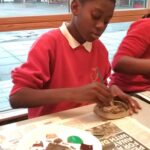Willow class have been learning about the Indus Valley civilization this term and exploring the art created during this time.
The Indus Valley civilization covered a massive area, four times the size of the UK. It centred on the Indus River, in modern day NE Afghanistan, Pakistan and NW India.
Lots of discovaries have been made from this era, including Indus Valley seals. The first seal was discovered by Alexander Cunningham in Harappa in 1872. Another archaeologist called Rakhal Banerji found more seals in 1919 & since then over 3500 seals have been found.
Most are square or rectangular, although circular ones have also been found.
The seals are usually about 25mm across – the size of a postage stamp. All seals have pictures on them and most have some writing. They are usually made from steatite or soapstone (a soft stone that gets harder when fired in a kiln).
On the back of the seals there is usually a projection/handle, probably to hold while pressing the seal into other materials such as clay. The projections also have a hole for thread, probably so the seal can be worn or carried like a necklace.
We explored further and discovered the designs were mostly animals or figures, with a few geometric patterns. We identified animals such as bulls, elephants, tigers, rhinoceros, gazelles and what looks like a unicorn!
We then experimented with colour and shape to create our own designs in our sketchbooks.
The next step was to use our sculpture skills to create a seal from air dried clay and add our chosen design. We chose an animal, human and Indus writing for our seal. We used our knowledge of colour to mix the appropriate shades and tones using water and acrylic paint to create a replica of an Indus Valley seal. We are extremely proud of our artwork, please ask us about the design we chose to use.

























